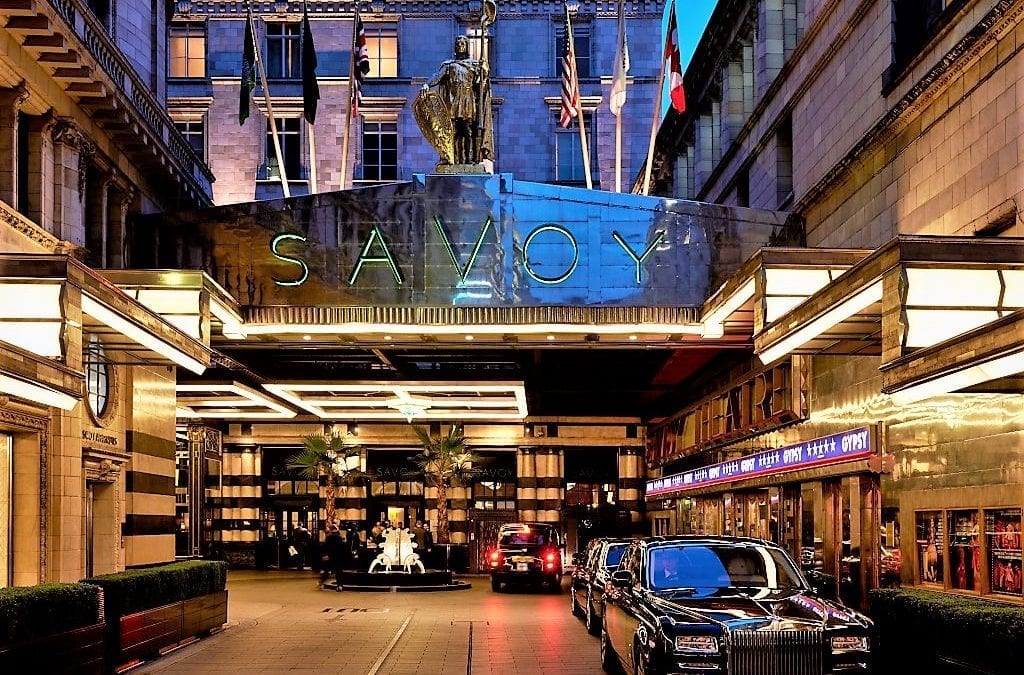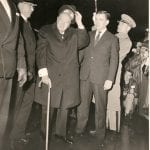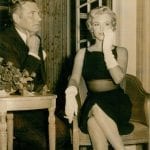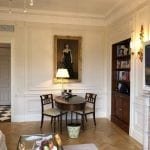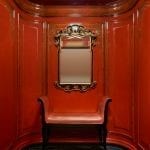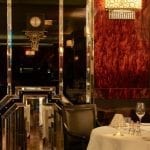Roger Hermiston and Eileen Wise spend a night at The Savoy, discovering the colourful history and wonderful cuisine of one of London’s foremost hotels.
Past the exquisite glass Lalique fountain and under The Savoy hotel’s stainless steel sign, once you enter Richard D’Oyley Carte’s pleasure dome you quickly encounter the ghosts of the famous figures who have swung through its gilded front doors over the past 132 years.
Look there’s Marilyn Monroe, radiant and flirtatious in a tight black dress, holding a press conference in the Thames Foyer on her honeymoon in 1956, smitten British newsmen applauding and cheering her every wisecrack. Move across into the sumptuous Art Deco restaurant The Savoy Grill, where another cool, elegant blonde, Grace Kelly, sits at her favourite table at the back of the room, the perfect vantage point from where she likes to observe the comings and goings.
Downstairs in the private Pinafore dining room Winston Churchill refills his brandy glass, lights a cigar and settles back for some crackling conversation with friends, Conservative, Liberal and Labour alike, at a regular fortnightly meeting of The Other Club, London’s political dining society which he co-founded. And up on the roof, watch as a slim, agile Fred Astaire shows off his latest routine with his dance partner and sister Adele.
This is the thrill of a stay at The Savoy hotel – to feel your imagination stirred by the tales of those who have gone before, royalty, statesmen, celebrities, spies, the great and the good – and sometimes the not so good; the hotel recorded a killing, many moons ago, by a Parisienne courtesan, who was, however, eventually acquitted of murder.
A Private Tour of The Savoy Hotel
Susan Scott is the official keeper of this bounty of great memories. Susan is The Savoy hotel’s in-house archivist, a post surely unique in the great hotels of the world. So stimulating is this (part-time) position that she will be celebrating twenty five years in June 2021.
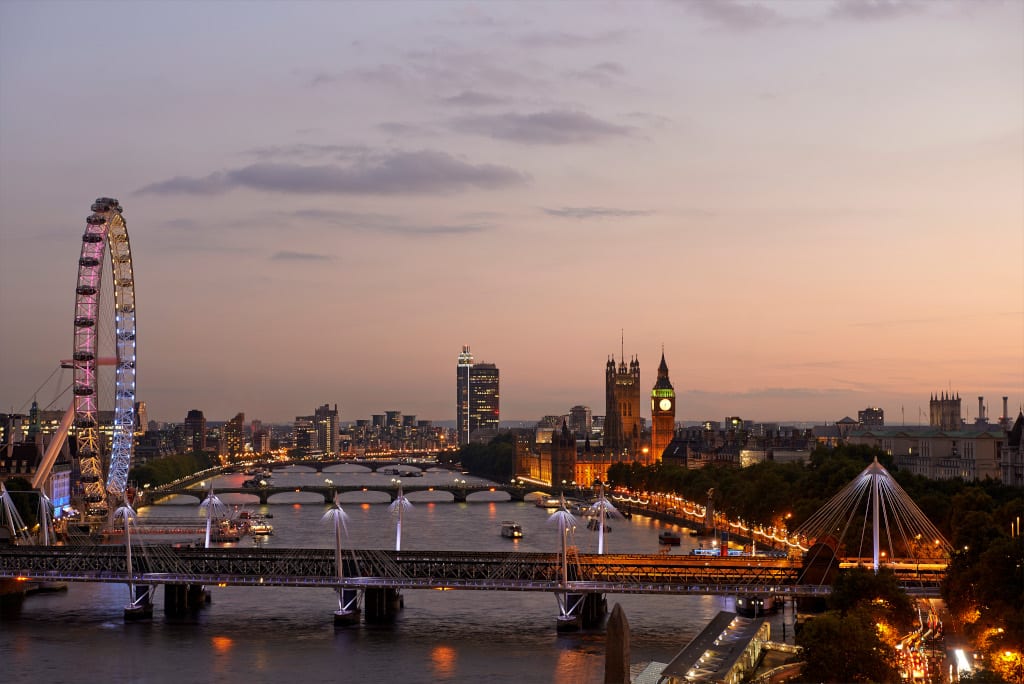
Susan took us on a fascinating private two-hour tour of the hotel before we settled in to enjoy its comforts. We had a walk round the jewel in the crown of the 267 rooms and suites, the Royal Suite, which consists of a luxurious, open-plan parade of rooms stretching along the entire fifth floor.
The views are spectacular, the Thames panorama laid out before you all the way up from the Houses of Parliament in the West to Canary Wharf in the East. It was on this floor, in the hotel’s early years, that the great impressionist Claude Monet weaved his magic. Setting his easel out on the balcony – sadly none of which remain today, the space taken up for bathrooms – he set out to paint the capital’s famous waterway and its principal bridges; nearly all when fogbound.
“London wouldn’t be a beautiful city. It’s the fog that gives it its magnificent breadth,” he claimed, revelling in the changes of light patterns wrought by the haze. His Waterloo Bridge, painted from the fifth floor in 1904, would fetch nearly £18 million at auction just over a century later. The Savoy’s other great artist guest, the American James McNeill Whistler, also produced atmospheric paintings of the Thames, but he booked his place in the hotel’s history with his famous sketch in 1897 of the scaffolding being erected, two years before the actual opening.
The Savoy London Stories
Two of Susan’s stories were particularly fascinating. First, she took us into one of the Art Deco rooms, where the most stylish waste paper bin stood, made out of aluminium and erected in three cylindrical tiers like a nouveau 1930s building. Apparently Churchill – who had an account here for many years – loved these bins and ordered fourteen of them. Quite probably they were the perfect receptacles for his discarded cigars.
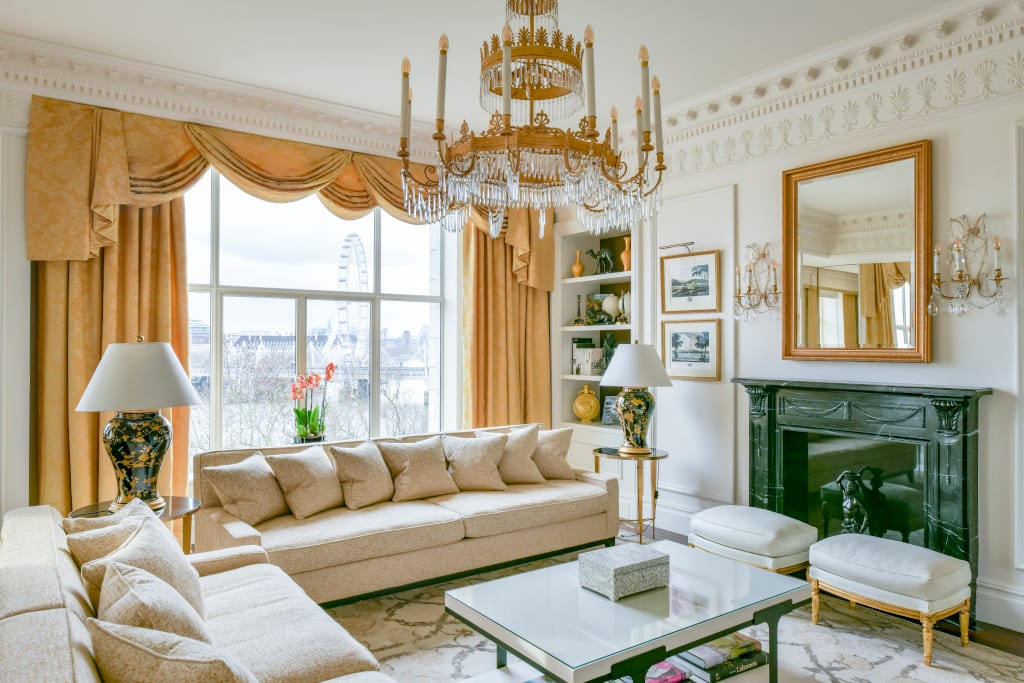
Then she led us into one of the oldest private dining-rooms, the Princess Ida & Patience. “This is where Brexit began,” she proudly asserted. In a sense she was quite right. It was in this room, in October 1943, that the leaders of the governments-in-exile of Belgium, The Netherlands and Luxembourg (‘Benelux’) signed the first European currency agreement, triggering the long chain of events leading to ever-closer European union – and eventually the campaign to halt Britain’s part in it by Messrs. Johnson and Cummings.
Boris Johnson’s portrait does not yet feature on the wall of the Pinafore Room next door, but nearly all the other Prime Ministers of the 20th and early 21st century do. This is the home of The Other Club, founded by Churchill (then a Liberal) and his loquacious barrister friend, the Conservative F E Smith, in 1911. “Nothing in the rules or intercourse of the Club shall interfere with the rancour or asperity of party politics,” Churchill declared at the outset.
The table is shaped like an ocean liner – similar to the one in the Cabinet Room in 10 Downing Street – and next to its head is a bronze statue of the great man, flashing his ‘V for Victory’ sign. Churchill insisted to coming to dine here even in The Blitz: who knows what crucial wartime decisions were taken as the Roast Beef Wellington was consumed.
The Savoy : a Ground-breaking Hotel
The Savoy may be home to the celebrities, but the recent four-part documentary of the hotel on ITV has made stars of its own staff. One of them, the ebullient Head Butler Sean Davoren, greeted us on our arrival in typically warm Savoy fashion. Another, the extrovert Restaurant Director Thierry Tomasin, would regale us later with anecdotes over our dinner in the Savoy Grill.
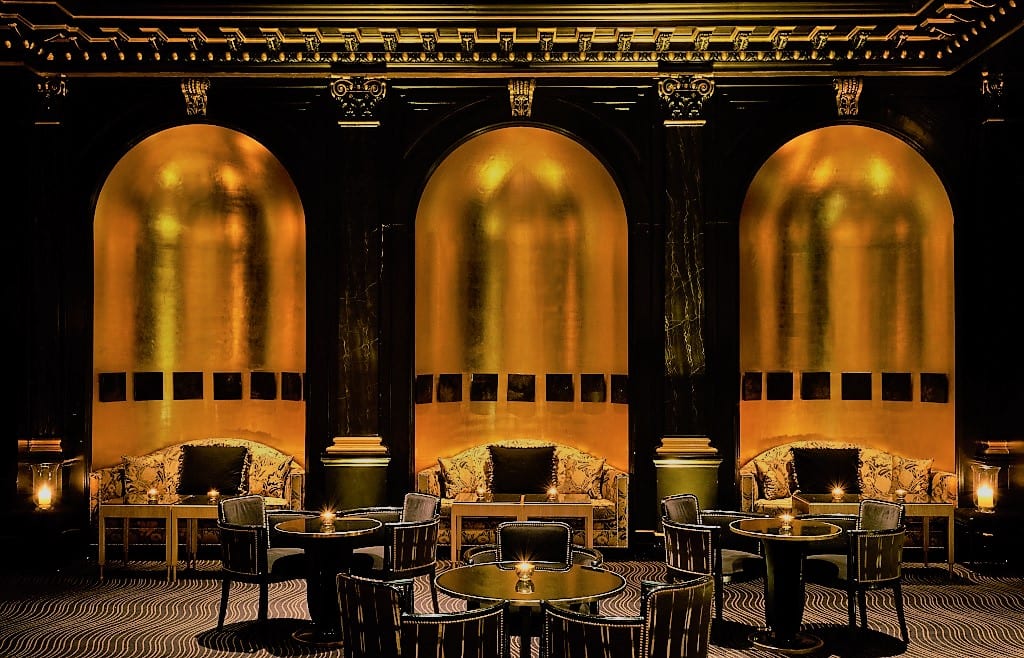
This may be an elite hotel, but the attitude of all of the staff is friendly and down-to-earth, aimed at putting you at your ease in imposing surroundings. Apart from the obvious skill of the visible staff, you marvel at the professionalism of the unnoticed cleaners. We noted the spotless state of the place – especially commendable during the pandemic, with a limited number of employees – as we wandered around the corridors.
We ascended to our room on the fourth floor in one of The Savoy’s great artefacts – the Red Lift. ‘Affectionately’ (as the inscription above its double doors says) known as the Ascending Room, this was London’s first ever electric lift, installed for the 1889 opening. The red leather seat at the back – which can accommodate two ladies – still remains, as does an ornate mirror.
The Savoy has always been at the cutting edge of technology. In addition to the lift, it lays claim to being the first superior hotel in this country to be lit by electric light, the first to boast constant hot running water, and the first to install air-conditioning.
A Suite with a View
We were staying in what The Savoy describes as a ‘Personality River View Suite’ – there are five, named after the aforementioned Churchill and Monet, together with Charlie Chaplin, Katherine Hepburn and ours, the Maria Callas suite.
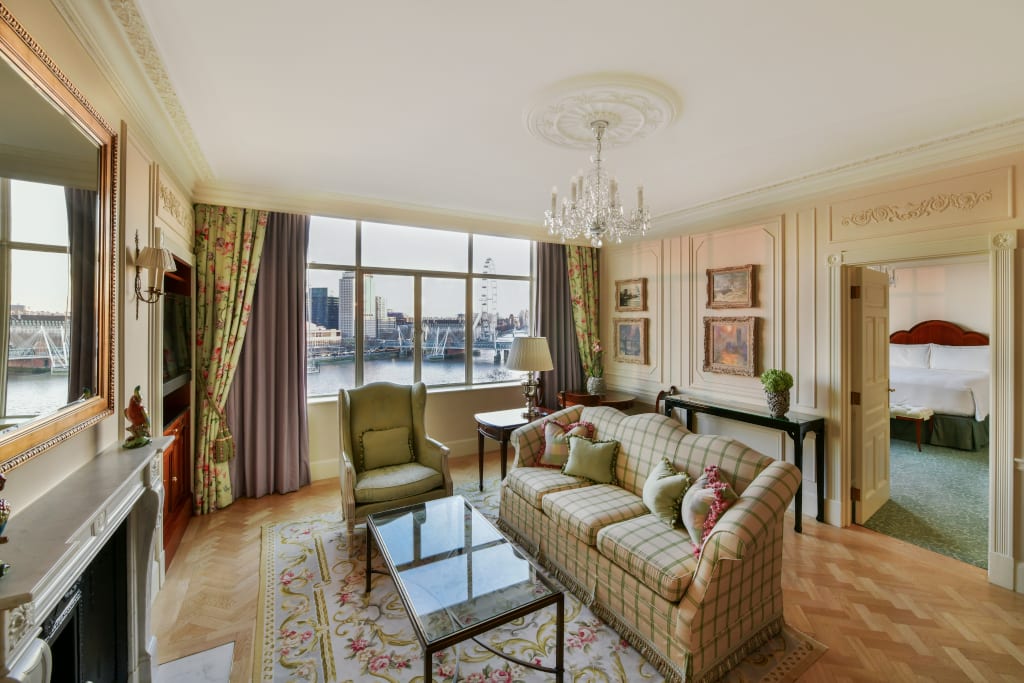
A huge, beautiful portrait painting of the brilliant but troubled American-born Greek soprano in evening gown adorns the wall of the suite’s sitting-room, and there are numerous other intimate photographs of her dotted around, along with books and DVDs about her life and career.
It’s an elegant, spacious suite, Edwardian in style, with a marble entrance foyer, large cloakroom area, and a sitting room comprising sofa, two armchairs and a writing desk that can convert into a dining table.
The en suite bathroom, with The Savoy’s characteristic black and white chequer board flooring, leaves nothing to be desired, with superb walk-in shower and claw-tub bathtub. You could say the same about the bedroom, too, with its king-sized bed to sink into, plus dressing table and armchair.
Then of course there’s the stupendous view of the city, which we had already experienced during our trip to the Royal Suite. It was just as impressive at night, with the London Eye – its pods lit up in purple – seemingly within touching distance to our right, and the Southbank Centre with the Royal Festival Hall at its heart, mournfully advertising shows that probably won’t happen, straight ahead.
The Savoy Photo Gallery
After a Savoy afternoon tea and a slumber, we ascended in a blue lift (as opposed to the red – getting in the wrong one can knock you seriously off course) to the third floor and the Beauty and Fitness area. In these Covid-19 times, numbers are restricted in the nine-metre swimming-pool, which was a boon as we had it all to ourselves for an hour.
The pool is situated directly beneath the central atrium, allowing for natural daylight to flood in. It is equipped with a jet stream, which you can attempt to swim against – or perhaps lie back, and use it to provide massage for a stiff back. Half-an-hour’s length swimming and we were ready to tackle dinner.
Cocktails in the Beaufort Bar
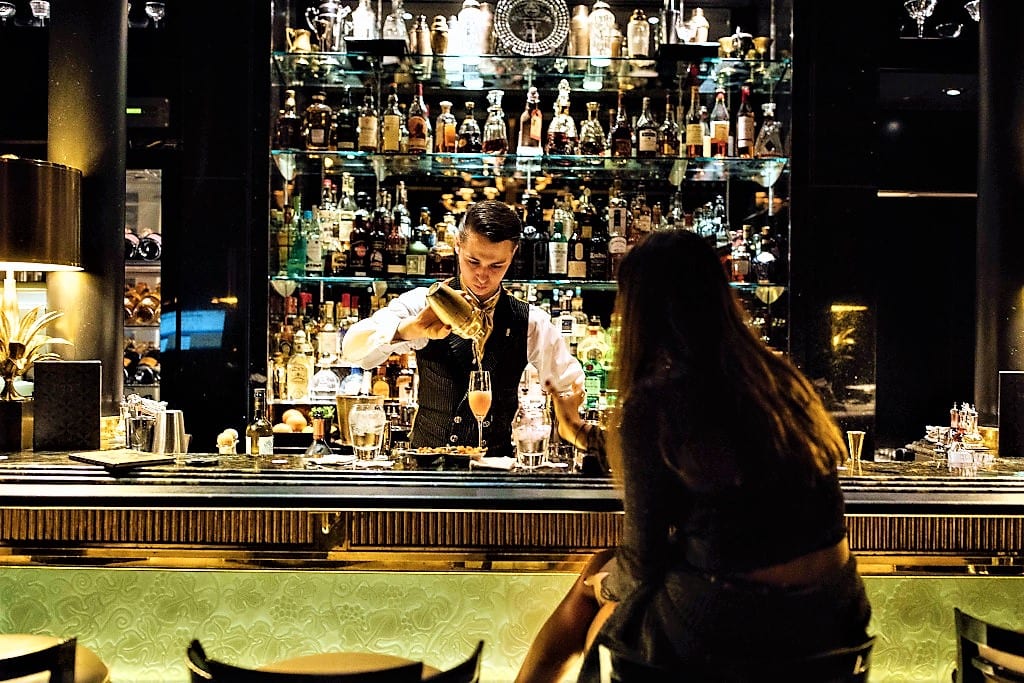
But first cocktails in the darkly theatrical Beaufort Bar, with its opulent black velvet furnishings and gold leaf on the walls, sipping our drinks to the accompaniment of the resident pianist playing – tonight – well-known ballads from the 70s and 80s. The raised bar here is where the cabaret stage once was, home to composer George Gershwin and pianist Carroll Gibbons.
Then to dinner. Many of the chefs at The Savoy have acquired legendary status, none more so than Francois Latry, in charge in World War 2, who endeavoured to come up with a recipe to meet the needs of those austere times. He invented a dish consisting simply of King Edward potatoes, mushrooms, leaks and carrots – and named it Lord Woolton Pie after the Minister of Food, with the full recipe published in The Times in March 1941.
Woolton joked that it was “steak and kidney pie without the steak and kidney”. Susan Scott, who has tasted it and found it surprisingly delicious, feels it is more “chicken pie without the chicken”. Either way, it has taken its place in the culinary history book.
Dinner at the Savoy Grill
Grim though 2020 has been, there is no reason for Gordon Ramsay and his team at the Savoy Grill to compromise on their fine dining. We were first guided through the menu and offered evocative little stories from the engaging Monsieur Tomasin. It was a master class, watching him settle and entertain the diners as they awaited their food in a full room that night.

And what food it was. First was the restaurant’s signature starter, the Arnold Bennett soufflé, named after the great English novelist who lived in the hotel in the 1920s and based his last novel, Imperial Palace, on it. It’s a delicious fluffy omelette, with smoked haddock, hollandaise sauce and cheese, perfected to Bennett’s taste a hundred years ago and still going strong.
We followed this up with a Dover Sole Grenobloise, a beautifully filleted fish in a wonderful sauce of browned butter, capers, parsley and lemon. Rounding things off excellently was a light, sweet citrus mille feuille. We don’t normally drink chardonnay, but our sommelier selected a delightfully light variety which went down a treat.
Our stay had been in the middle of the pandemic, when there was no lockdown but the necessary safeguards and restrictions. Yet we barely noticed, such were the pleasures of the place and the ultra-professional efforts of the reduced staff. It is easy to see why The Savoy retains its place at the top table.
If you have enjoyed Eileen and Roger’s experience at The Savoy, then read their previous stay in the UK capital while dining at Simpson’s on the Strand in A Night in London Across the Ages.
For more information on The Savoy, click here.
